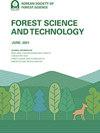Identifying non-thrive trees and predicting wood density from resistograph using temporal convolution network
IF 2.2
Q2 FORESTRY
引用次数: 0
Abstract
Abstract Deep learning approaches have been adopted in Forestry research including tree classification and inventory prediction. In this study, we proposed an application of a deep learning approach, Temporal Convolution Network, on sequences of radial resistograph profiles to identify non-thrive trees and to predict wood density. Non-destructive resistance drilling measurements on South and West orientations of 274 trees in a 41-year-old Douglas-fir stand in Marion County, Oregon, USA were used as input series. Non-thrive trees were defined based on their changes in social status since establishment. Wood density was derived by X-ray densitometry from cores obtained by increment borers. Data was split for cross validation. Optimal models were fine-tuned with training and validation datasets, then run with test datasets for model evaluation metrics. Results confirmed that the application of the Temporal Convolution Network on resistograph profiles enables non-thrive tree identification with the probability, represented by the area under the Receiver Operator Characteristic curve, equal to 0.823. Temporal Convolution Network for wood density prediction showed a slight improvement in accuracy (RMSE = 18.22) compared to the traditional linear (RMSE = 20.15) and non-linear (RMSE = 20.33) regression methods. We suggest that the use of machine learning algorithms can be a promising methodology for the analysis of sequential data from non-destructive devices.利用时间卷积网络从电阻图中识别非繁茂树木并预测木材密度
摘要深度学习方法已广泛应用于林业研究,包括树木分类和库存预测。在这项研究中,我们提出了一种深度学习方法——时间卷积网络(Temporal Convolution Network)——在径向电阻曲线序列上的应用,以识别非繁茂树木并预测木材密度。以美国俄勒冈州马里恩县一个41年树龄的道格拉斯冷杉林274棵树的南向和西向非破坏性阻力钻孔测量作为输入序列。不茁壮的树木是根据其建立以来社会地位的变化来定义的。木材密度是通过x射线密度测定法从增量钻孔工获得的岩心中得出的。将数据分开进行交叉验证。使用训练和验证数据集对最优模型进行微调,然后使用测试数据集运行模型评估指标。结果证实,将时序卷积网络应用于电阻谱剖面,可以实现非茁壮树的识别,其概率为0.823,由接收算子特征曲线下的面积表示。与传统的线性(RMSE = 20.15)和非线性(RMSE = 20.33)回归方法相比,时序卷积网络用于木材密度预测的准确率(RMSE = 18.22)略有提高。我们建议使用机器学习算法可以成为一种有前途的方法,用于分析来自非破坏性设备的顺序数据。
本文章由计算机程序翻译,如有差异,请以英文原文为准。
求助全文
约1分钟内获得全文
求助全文

 求助内容:
求助内容: 应助结果提醒方式:
应助结果提醒方式:


